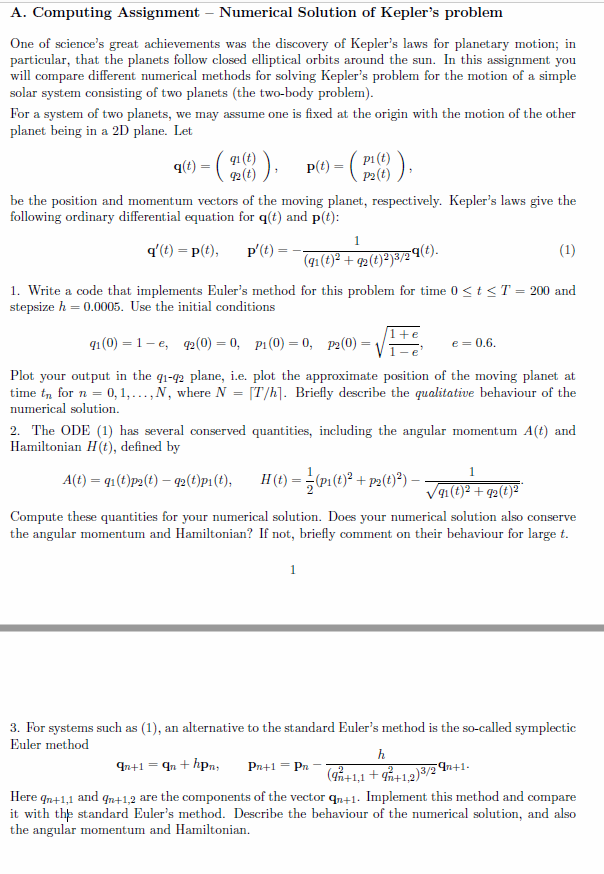Question
I'd like the solution to the third part if all of it isn't possible :) clear a = 0; % start time b = 200;

I'd like the solution to the third part if all of it isn't possible :)
clear a = 0; % start time b = 200; % end time e = 0.6;
% initial conditions q10=1-e; % given q20=0; % given p10=0; % given p20=sqrt((1+e)/(1-e)); % given
% Stepsize and mesh h = 0.0005;
tt=a:h:b; % Mesh N=length(tt); % 400,000 if h = 0.0005, b=200 q1=zeros(N,1); % Values for q1 q2=zeros(N,1); % Values for q2 p1=zeros(N,1); % Values for p1 p2=zeros(N,1); % Values for p2 at=zeros(N,1); % Values for at Ht=zeros(N,1); % Values for Ht
q1(1)=q10; % Initial values q2(1)=q20; % Initial values p1(1)=p10; % Initial values p2(1)=p20; % Initial values
% % Euler Steps
for i=1:N-1 dP = -1*((1/(q1(i)^2 + q2(i)^2))^(3/2)); p1n = p1(i) + h*dP*q1(i); p2n = p2(i) + h*dP*q2(i); p1(i+1) = p1n; p2(i+1) = p2n; q1n = q1(i) + h*p1(i); q2n = q2(i) + h*p2(i); q1(i+1) = q1n; q2(i+1) = q2n; at(i)=(q1(i)*p2(i))-(q2(i)*p1(i)); % angular momentum
Ht(i)=0.5*(((p1(i))^2)+(p2(i))^2)-(1./(sqrt((q1(i))^2+(q2(i))^2))); end
hold on %plot(q1, q2) plot(q1, q2) title('Euler''s Method on Kepler''s problem','fontsize',14) xlabel('x-position','fontsize',12) ylabel('y-position','fontsize',12) legend({'Planet Around the Sun'},'fontsize',14,'Location','northwest') figure plot(at) figure plot(Ht) % plot(Ht)
this is what I have
A. Computing Assignment Numerical Solution of Kepler's problem. One of science's great achievements was the discovery of Kepler's laws for planetary motion. in particular, that the planets follow closed elliptical orbits around the sun. In this assignment you will compare different numerical methods for solving Kepler's problem for the motion of a simple solar system consisting of two planets (the two-body problem) For a system of two planets, we may assume one is fixed at the origin with the motion of the other planet being in a 2D plane. Let be the position and momentum vectors of the moving planet, respectively. Kepler's laws give the following ordinary differential equation for q and p( (t) (1) 2 3/2 1. Write a code that implements Euler's method for this problem for time 0 St ST 200 and stepsize h 0.0005. Use the initial conditions Plot your output in the q1-q2 plane, i e. plot the approximate position of the moving planet at time tn for n 0.1 N, where N hl. Briefly describe the qualitative behaviour of the numerical solution. as several conserved quantities, including the angular momentum A 2. The ODE (1) and Hamiltonian H(t), defined b Compute these quantities for your numerical solution. Does your numerical solution also conserve the angular momentum and Hamiltonian? If not, briefly comment on their behaviour for large t 3. For systems such as an alternative to the standard Euler's method is the so-called symplectic Euler method h n-t-1 n-t-1 n--1 3/2 (ga +1,1 ere gn+1.1 and 2 are the components of the vector qn+1 Implement this method and compare it with the standard Euler's method. Describe the behaviour of the numerical solution, and also the angular momentum and HamiltonianStep by Step Solution
There are 3 Steps involved in it
Step: 1

Get Instant Access to Expert-Tailored Solutions
See step-by-step solutions with expert insights and AI powered tools for academic success
Step: 2

Step: 3

Ace Your Homework with AI
Get the answers you need in no time with our AI-driven, step-by-step assistance
Get Started


